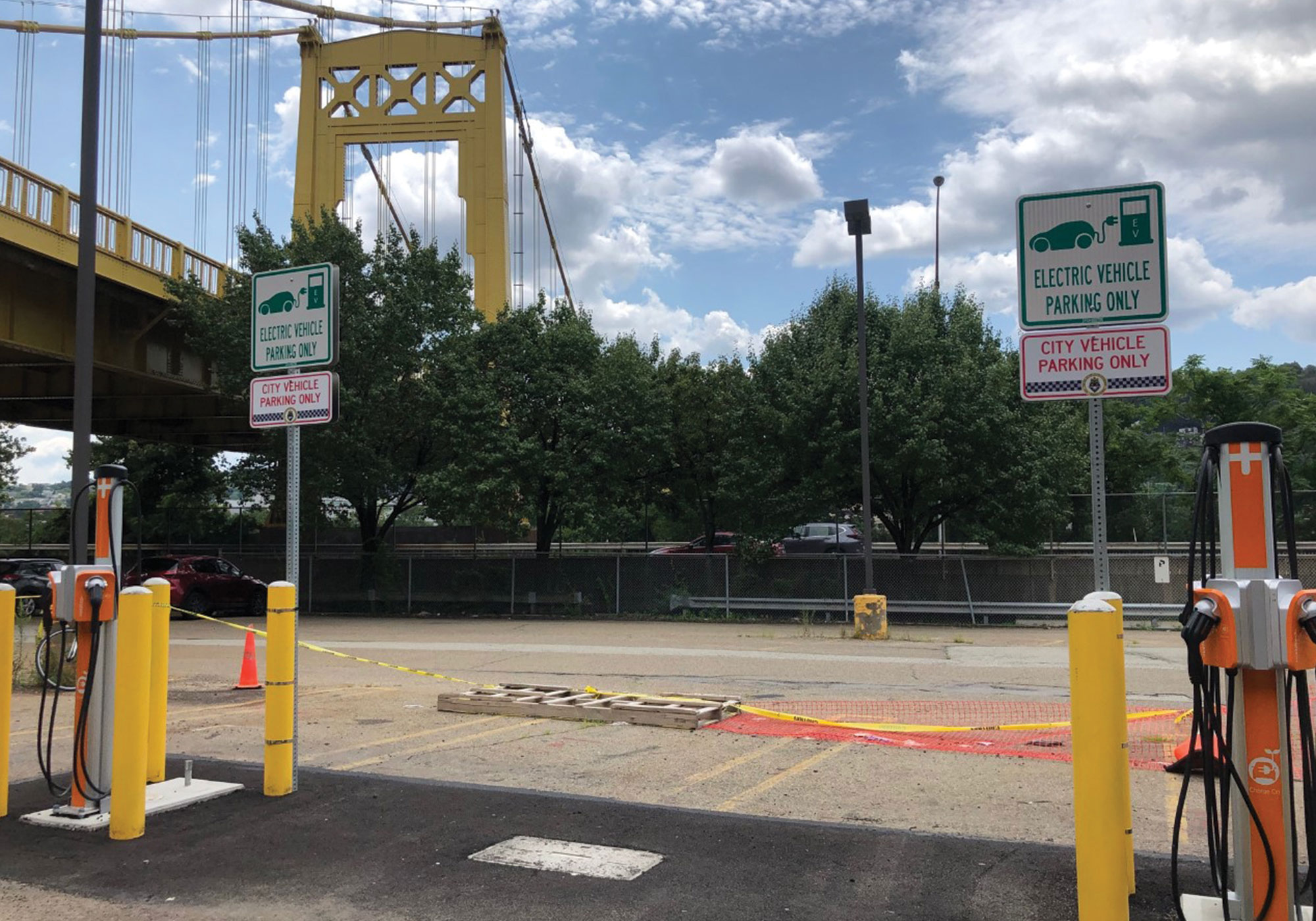This story is part of the Cities + Solutions series, which chronicles surprising and inspiring climate initiatives in communities across the U.S. through stories of cities leading the way. For more solutions stories like these, subscribe to the Looking Forward newsletter.
Governments the world over have made a lot of great-sounding climate commitments. In Pittsburgh, for example, an ambitious plan adopted in 2018 outlines objectives like 100 percent renewable energy in municipal facilities by 2030, a fossil-free fleet, and zero-waste operations. But setting goals is one thing. Implementing the programs and infrastructure needed to reach them is another — and that work costs money.
“We had a large, ambitious agenda, but very little resources that went alongside it,” says Grant Ervin, Pittsburgh’s former chief resilience officer who oversaw creation of the 2018 plan. “Following the completion of our resilience strategy and our climate action plans, we were asking the question: Where is the money to help implement these different initiatives that we had identified?”
Answering that was tricky for this midsize post-industrial city, which was designated as “financially distressed” from 2003 until early 2018. For Ervin, the challenge went beyond raising funds for new initiatives. He wanted to ensure the city’s spending — all of its spending — aligned with its climate and equity promises. “If we’re going to address the climate challenge,” he remembers thinking, “we’re going to have to start to leverage our existing resources to do the things that we know we need to do.”
For Steel City, that meant scrutinizing its entire spending plan through a climate lens with the help of a method called priority-based budgeting.
The challenge: budgeting for a cause
There are several ways an organization can slice its budget. One common approach is incremental budgeting, wherein the previous year’s budget provides the baseline for the next, with incremental adjustments. It’s easy to imagine how that might lead to inefficiencies when line items get carried over year after year.
Priority-based budgeting, on the other hand, maps every single dollar a city spends to a specific program — everything from “rodent baiting” to recycling collection — then scores each one according to how it achieves the city’s priorities. Although the method could be used in the private sector, it was developed for local governments, which work toward the common good rather than a profit margin.
“We’re going to have to start to leverage our existing resources to do the things that we know we need to do.”
– Grant Ervin
“There are so many societal objectives that are really up to local governments to mount a charge to try to solve,” says Chris Fabian, who developed the approach to budgeting around 2010. After years in the public sector, he saw that municipal budgets were not designed to reveal how much money was going toward objectives like climate action, equity, or resilience. Such efforts were often bundled into many different line items, making accountability difficult. He wanted to develop a system that would help cities see how they could redistribute resources to finance their top priorities — from general goals like fostering safe, healthy communities to specific projects like addressing homelessness.
Fabian cofounded the software and consulting company ResourceX in 2015 and has since helped over 300 local governments across the U.S. and Canada adopt priority-based budgeting. Common priorities the company helps cities advance include equity, safety, and thriving economies. “It does vary,” Fabian says. “If you go into some conservative communities, they might not feel that they have a role in economic vitality. They’re like, ‘The business sector should figure it out on their own.’ Whereas other places invest heavily in visitors bureaus and convention centers and so on.”
Climate, he says, is something of a new focus for the municipalities he and his team work with. In 2020, Pittsburgh became the first to use the process to develop a climate-first budget for the entire city.
Pittsburgh’s goal: a zero-carbon budget
When Ervin worked for the city of Pittsburgh, he visited towns around the world to learn how they were integrating climate priorities into their spending. Although some Scandinavian cities employ “carbon budgeting” — a greenhouse-gas accounting system that resembles a fiscal plan — Ervin never found an example of a comprehensive financial plan that accounted for climate and equity priorities.
“One of the things that we had as a goal was to eventually have a zero-carbon budget” — one that wouldn’t cause any net increase in carbon emissions — says Will Bernstein, who became an advisor to Pittsburgh through its participation in Bloomberg Philanthropies’ American Cities Climate Challenge, and is now the city’s climate and energy manager. “But we didn’t really know exactly how to get there in terms of understanding the budget, and how you construct that and how you measure that.” With the help of a $50,000 grant from the challenge, Pittsburgh hired ResourceX to pursue its goal.
“They reached out and said, ‘We found you guys through a Google search,’” Fabian recounts, “‘and it seems like you might have the tool that we’re looking for, to get budget alignment toward a priority. Have you ever done it on climate?’”
Over a period of roughly three months in the fall of 2020, city officials tracked nearly every dollar in the $600 million operating budget to a specific program, then scored each program against Pittsburgh’s climate and equity priorities. Of 27 departments, only four did not participate in the process. Then, in early 2021, over 50 representatives from those departments joined a series of workshops to pitch ideas for where costs could be cut and revenue generated, and how that money could finance the city’s climate goals. Pittsburgh identified $41 million that could be reallocated toward climate and equity initiatives. However, those dollars didn’t move right away — and some still haven’t.
“Sometimes it’s difficult to see a one-to-one transition,” says Patrick Cornell, deputy director of Pittsburgh’s Office of Management and Budget. The goal of a priority-based budget isn’t necessarily to kill any program that doesn’t score highly and move the money to ones that do. It’s an iterative process, more akin to what Ervin hoped to do with the budget: see where the city’s spending might be running counter to its climate objectives, and how that could be fixed over time — whether by ending a program, or changing the way work gets done.

One example of a relatively straightforward shift is electrifying the city’s fleet. “Currently, any sedans that need to be replaced are being replaced with electric,” says Rebecca Kiernan, assistant director of the Department of City Planning, who leads the sustainability and resilience division. But, she adds, the budget is always tight, and the city was already decades behind in updating its fleet. She and her team are also accelerating the EV transition with the help of federal money. This year, the city is getting eight electric recycling trucks, with funding from the American Rescue Plan and the EPA’s Targeted Airshed Grants Program. “Those are gonna be our first [electric] heavy-duty fleet vehicles. So that’s really exciting,” Kiernan says.
Eliminating paper contracts — something Ervin called “master of the obvious” — is an example of changing the way work gets done. A city ordinance approved in November 2021 requires the use of electronic signatures for all city business. Not only did that free up around $50,000 a year by Kiernan’s estimate, it reduced waste.
Priority-based budgeting: one tool in the box
Pittsburgh enacted its first priority-based spending plan in 2022, a $615 million operating budget that provided, among other things, the money to create Bernstein’s position. The city is still quite a ways off from having a zero-carbon budget. But the priority-based approach appears to have staying power. The city will continue working with ResourceX for at least another three years, aiming to get closer with each iteration to a budget that reflects its climate and equity goals.
Prior to working with the American Cities Climate Challenge, Cornell wouldn’t have considered priority-based budgeting much more than a fad. “Different things become popular depending on what major cities are doing, or what is new in the thrilling world of municipal budgeting,” he says. And he admits that some departments found the process more intuitive than others. But he and his team have gotten behind the approach — so much so that he took up the mantle of pitching it to the new administration when the mayor’s office changed hands in 2022. Everyone was keen to keep going with it. “We’re able to think more holistically about different programs that residents are concerned about,” he says.
And the city has also used that holistic thinking as an opportunity to communicate more openly with residents. In the fall of 2022, Pittsburgh launched a public-facing tool that allows anyone to explore the city’s new priority-based budget and see how various city-funded programs benefit residents. “That’s a brave act,” says Erik Fabian, Chris’s brother and the business development manager at ResourceX. “It’s transparent — some programs are more aligned than others. So that’s being communicated, and putting the city in a position of accountability.”
Explore more Cities + Solutions:
- New Orleans lost its bike share. Residents stepped up to rebuild it with a focus on equity.
- A California town’s wastewater is helping it battle drought
- Can cities eliminate heat-related deaths in a warming world? Phoenix is trying.
- Ann Arbor’s path to decarbonization begins in one of its most frontline communities
- Lessons from the Flathead Reservation’s comprehensive climate plan



